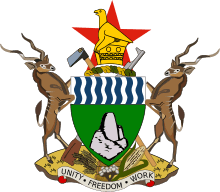Constitution of Zimbabwe
 |
| This article is part of a series on the politics and government of Zimbabwe |
|
Legislature |
|
Judiciary |
|
National symbols |
The Constitution of Zimbabwe is officially the supreme law of Zimbabwe. The independence constitution of 1980 was the result of the 1979 Lancaster House Agreement and is sometimes called the Lancaster Constitution.[1] A proposed constitution, drafted by a constitutional convention, was defeated by a constitutional referendum during 2000.
In practise, after 2008, the 2008 power-sharing deal provided the structure for much of the government. The three political parties in Zimbabwe, ZANU-PF, MDC-T and MDC-N negotiated a new proposed constitution after a constitutional outreach program.[2] The new constitution was approved in the referendum of 16 March 2013.[3][4] The parliament approved it on 9 May 2013. Some of the new constitution's clauses do not take effect for 10 years.[5]
| Wikisource has original text related to this article: |
References
- ↑ Radio VOP. "Zimbabwe's Lancaster Constitution No Longer An Option". The Zimbabwean. Retrieved 18 February 2011.
- ↑ Thornycroft, Peta. "Zimbabwe's Constitutional Outreach Program Ends". Voice of America.
- ↑ Zimbabwe approves new constitution. BBC. 19 March 2013
- ↑ Dzinesa, Gwinyayi. Zimbabwe: The Battle for Credible Polls in Zimbabwe Intensifies. Institute for Security Studies, distributed by AllAfrica Global Media (allAfrica.com) 17 April 2013.
- ↑ Allison, Simon. Even Zimbabwe's constitution waits for Mugabe to pass the baton, or pass away: With crucial clauses not taking effect for 10 years, document recognises that nothing will change with the president around. Daily Maverick, part of the Guardian Africa Network (guardian.co.uk) Tuesday 26 March 2013
Further reading
- Hatchard, John (1991). "The Constitution of Zimbabwe: Towards a Model for Africa?". Journal of African Law. 35 (1–2): 79–101. doi:10.1017/s0021855300008378. JSTOR 745495.
- ——— (2001). "Some Lessons on Constitution-Making from Zimbabwe". Journal of African Law. 45 (2): 210–216. doi:10.1017/s0221855301001705. JSTOR 3558956.
- Sithole, Masipula (2001). "Fighting Authoritarianism in Zimbabwe". Journal of Democracy. 12 (1): 160–169. doi:10.1353/jod.2001.0015.